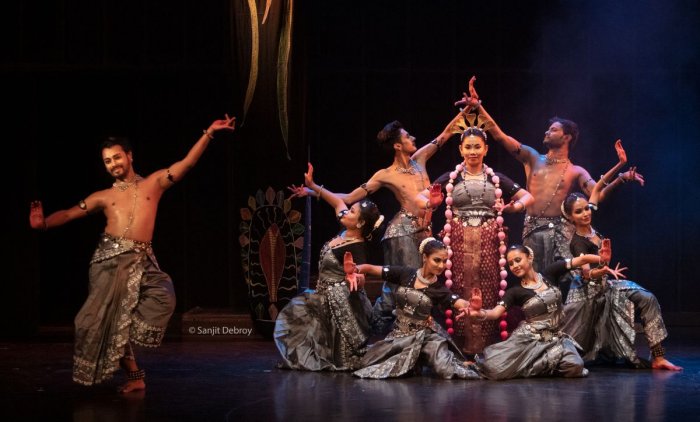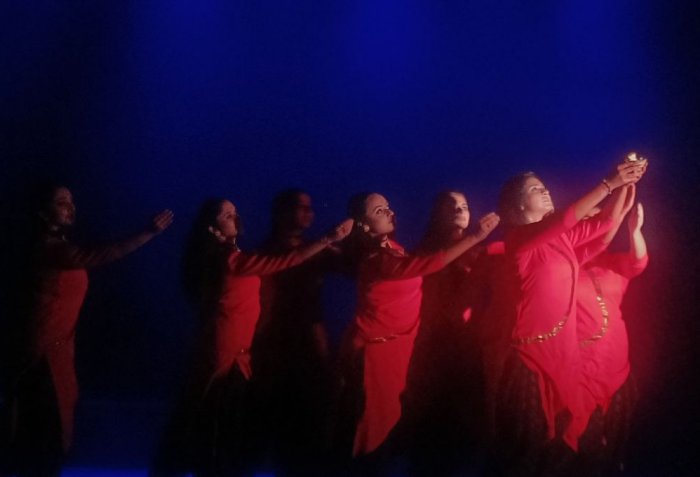
|   |

|   |
Some dancers who made a mark recently - Tapati Chowdhurie e-mail: tapatichow@yahoo.co.in March 9, 2025 Bharatiya Vidya Bhavan and G.L. Foundation presented Bharatanatyam exponent Mallika Sarabhai in 'Past Forward' at R.R. Sabha in Kolkata and Subhajit Kush Das and Jalsa Chandra at Birla Sabhaghar in 'Nritya Gatha.' All the three productions dealt with injustice meted out to the "fairer sex" irrespective of mortals or Goddesses. Mallika Sarabhai, Bharatanatyam exponent and choreographer, has been dancing for a decade less than half a century. She is the daughter of the power couple, atomic scientist Vikram Sarabhai and accomplished dancer Mrinalini Sarabhai. Her talent was recognized early in life. At the age of fifteen she was featured as Draupadi in Peter Brook's Mahabharata. She is presently the Chancellor of the Kerala Kalamandalam - a versatile genius, at ease talking about issues of the environment, women, communal harmony and violence through the medium of Bharatanatyam and the spoken word. She presented her solo production 'Shakti: The Power of Women' created in 1989, which is as popular today as it was then.  Mallika Sarabhai Dressed in an innovated Bharatanatyam costume, she told her life story without any gender bias, scripted in the language of dance. Each segment had a message inscribed on the screen at the back and was preceded with her address to the audience with her ready wit and humour asking them in no uncertain terms if they were comfortable with the misogynist situation that exists in a woman's everyday life. Mallika vociferated about the numerous injustices women face in their day to day life. She also spoke about the many movements that have happened around the world with a good measure of success. The production has created the intended awareness and each time it's staged it is as fresh as ever - if cheers after each performance can be taken as the yardstick. Facing crucial issues through dance has been her forte. Keeping the core thing in mind, her uniqueness reaches out to all. Her spontaneous presentation at Thyagaraja hall in Kolkata recently had the audience participating actively. She spoke about her roots, her journey - how she became a dancer, her childhood and early influences. She credits her parents' fulfilment with their own careers, which gave them the vision of making a proper ambience to help her choose her own career. In her eureka moment she chose dance as her career. Known for her radicalism, she took every step in her life to express her views through dance. Her presentation touched everyone present. She articulated about what a woman should do for the good health of the society. Her suggestions were savoured with great relish.  Manasa Mallika Sarabhai's work was on a contemporary topic, while Subhajit Khush Das' presentation in Birla Sabhaghar was based on Manasa, a folklore of Bengal produced and choreographed by Das, the Artistic Director of Bandel Subhangik Kolkata, in contemporary creative style. Manasa -The churning within... was an adaptation from the Padma Purana by Bijay Gupta. Indian folklore and folk culture are known for building bridges between the Gods and human beings. In Bengal, the Devis are treated like daughters. These Devis find no mention in the Vedas. Mangal Kavyas (Poems of Benediction) were composed between 13th and 18th centuries, notably consisting of narratives of indigenous deities of rural Bengal in the Middle Ages. They are written in the form of verses. Manasa is a Devi in the folklore of Bengal, who is not above human emotions. Subhajit Khush Das presented his neatly woven dance drama Manasa creatively. The story of Manasa, the snake goddess, is very popular in the rural areas of Bengal. Devi Manasa's fight with Chand Sadagar who refused to worship her was dramatically shown through contemporary dance. And the misery she was forced to shower on the merchant Chand Sadagar who refused to worship her is the subject matter of the story. The story of Manasa is about the stagnancy of classical text and the new found crisis of human existence that gave birth to the Goddess of the common folks. The crux of the story of Manasa is that she is not a Goddess in spite of being the daughter of Shiva. Anyone who did not worship her incurred her wrath was portrayed poignantly. As the leader of the snakes, she soon took away the lives of all of Chand's six sons. Manasa conspired with Ganga and drowned Chand's business ships. After losing everything to Manasa, Chand returned to Champaknagar where he finds his wife Sonoka with her new born seventh son Lakhindar. Chand had new hope. Time rolled and Lakhindar grew up to manhood. Soon Lakhindar was to marry the beautiful Behula only to be foiled by Manasa. If Chand still didn't want to worship her, Manasa would kill Lakhindar, on the first night of Lakhinder and Behula's marriage. Chand stood by his decision not to worship Manasa. He asked Lord Viswakarma to fashion an iron room which would prevent the snakes from getting in. Manasa promised Viswakarma that if he did not keep a hole in the iron room then he would face calamities too. Manasa forced Kalnagini to bite Lakhindar to death. In the face of many dangers, Behula then sailed with her husband's body in a raft in search of heaven. During her incredibly long journey to heaven, she faced thunderstorms, heat, attacks from wild animals and mystic illusion. Little did Behula know that she was plagued by Manasa. Behula's story was one of great love and resilience. In this version, a bit of the story of Lakhinder and Behula was also featured. The ordeals of Behula and Lakhinder came to an end in their later birth as Aniruddha and Usha where their love found fulfillment. The plethora of activities following one after the other was a breathtaking drama well conceived and choreographed in Modern Dance style. It involved a stage full of dancers entering and leaving the stage swiftly and imaginatively dancing their way into the hearts of the audience, who remained glued to their seats. The group has emerged as one of the very best storytellers of present times. In retelling the story of Manasa through Modern Dance, Das has touched upon crucial societal issues as well. Manasa not being worshipped on account of gender and caste issues is a burning issue of the times. The production of Manasa incorporated props that not only elevated its scenography but also supported a noble cause. During the pandemic, traditional pattachitra artists faced unemployment, prompting the team to collaborate with them to create props. Additional props, such as cane sticks and fabrics, were also thoughtfully integrated. Furthermore, the costumes were hand-painted by various marginal artists, drawing inspiration from traditional alpona designs. This deliberate choice celebrated indigenous artistry while providing a vital source of income for these artists during challenging times.  Agni Jalsa Chandra's Agni was a sort of protest against the injustice meted out to women. The work was a series of complaints. Felt and known facts like worshipping of Goddesses, while at that very moment a woman lies lifeless, bruised, soiled, naked. 'Agni' questioned the hypocrisy of our society and voiced the pain of women faced through ages in a stream of consciousness. It spoke of the tale of 'those women, these women, this woman.' Fire was the refuge in this story, the fire that consoled, entangled, burnt and yet protected. Choreography and direction were by Jalsa Chandra while the music was composed by Pandit Dishari Chakraborty. Accompanying artistes were stalwarts in their own fields. The solution, however feeble it may have been, should have been there too. It was a narration with an impressive beginning which lacked a solution.  Dr. Vidhi Nagar Dr. Vidhi Nagar made a mark with her solo performance at the Indian Classical Dance Festival by Dance Academy, Kolkata, at Rabindra Sadan. She was initiated into the grace of Kathak by Late Subhash Dixit, Deepa Deva from Bhatkhande Hindustani Sangeet Mahavidyalaya, Lucknow. Prof. Purnima Pande, Ex-Vice Chancellor, Bhatkhande Music Institute (Deemed University), Lucknow and Indira Kala Sangeet Vishwavidyalaya, Khairagarh, trained her in both Lucknow and Jaipur Gharana of Kathak. Vidhi Nagar has also trained under Pt. Birju Maharaj, Dr. Kanak Rele, Dr. Puru Dadhich and Kathak exponent Jayant Kastuar. She is well versed with the intricate nuances of both nritta and abhinaya. She has specialized in bhava elements of Kathak dance. For the past few years, she has been deeply involved in reviving the Baithiki style of traditional Kathak, thus innovating to go back to the roots of Kathak styles. She is the first woman to get a D.Lit. in the field of Kathak dance. She created an instant rapport with rasikas at Rabindra Sadan with her very first piece she performed - a Pada from poet Rashkha - "Morpakha sir upar rakhau gunj ki mal galeb paharungi" followed by the Thumri, "Kaha karu dekho gari det kanhai re" backing it up with a scintillating Tarana. "Rang pairahan ka khushbu" was a Ghazal, the abhinaya of which was unparalleled. She was a connoisseur's delight.  Tapati Chowdhurie trained under Guru Gopinath in Madras and was briefly with International Centre for Kathakali in New Delhi. Presently, she is a freelance writer on the performing arts. She is the author of 'Guru Gopinath: The Making of a Legend.' |